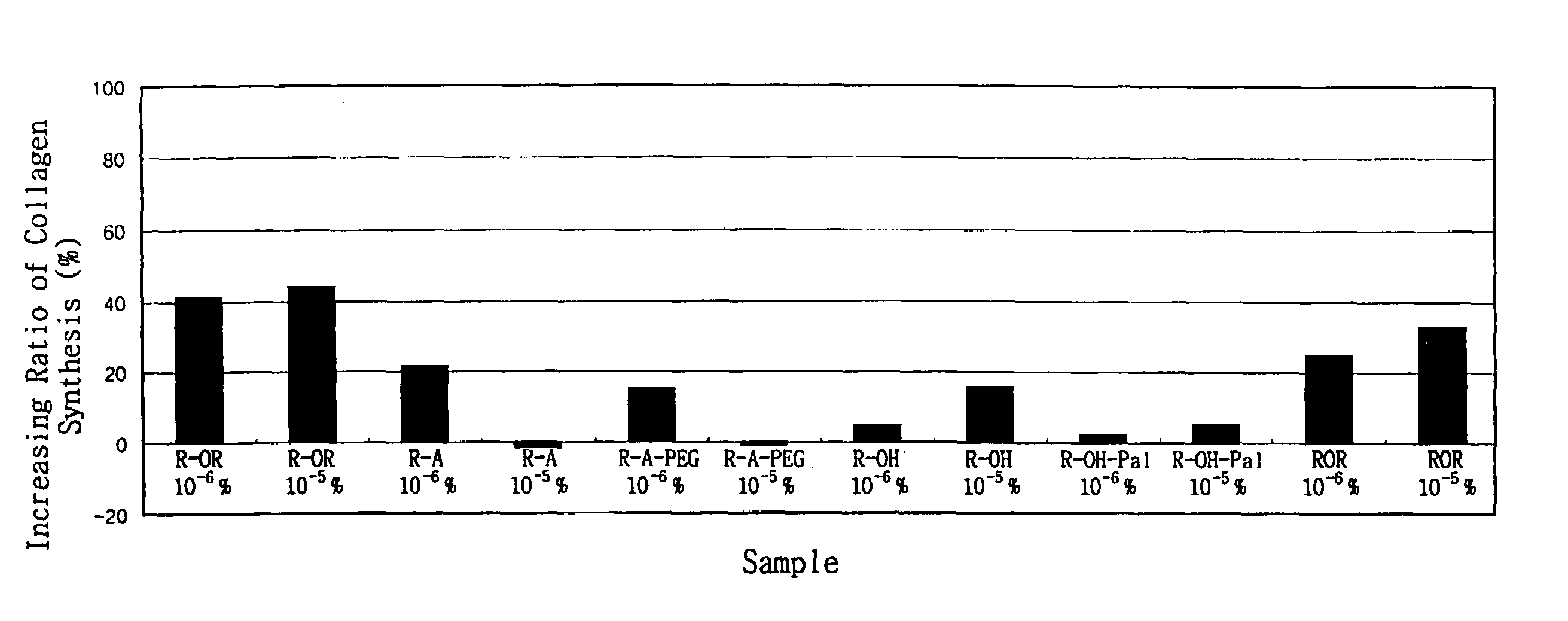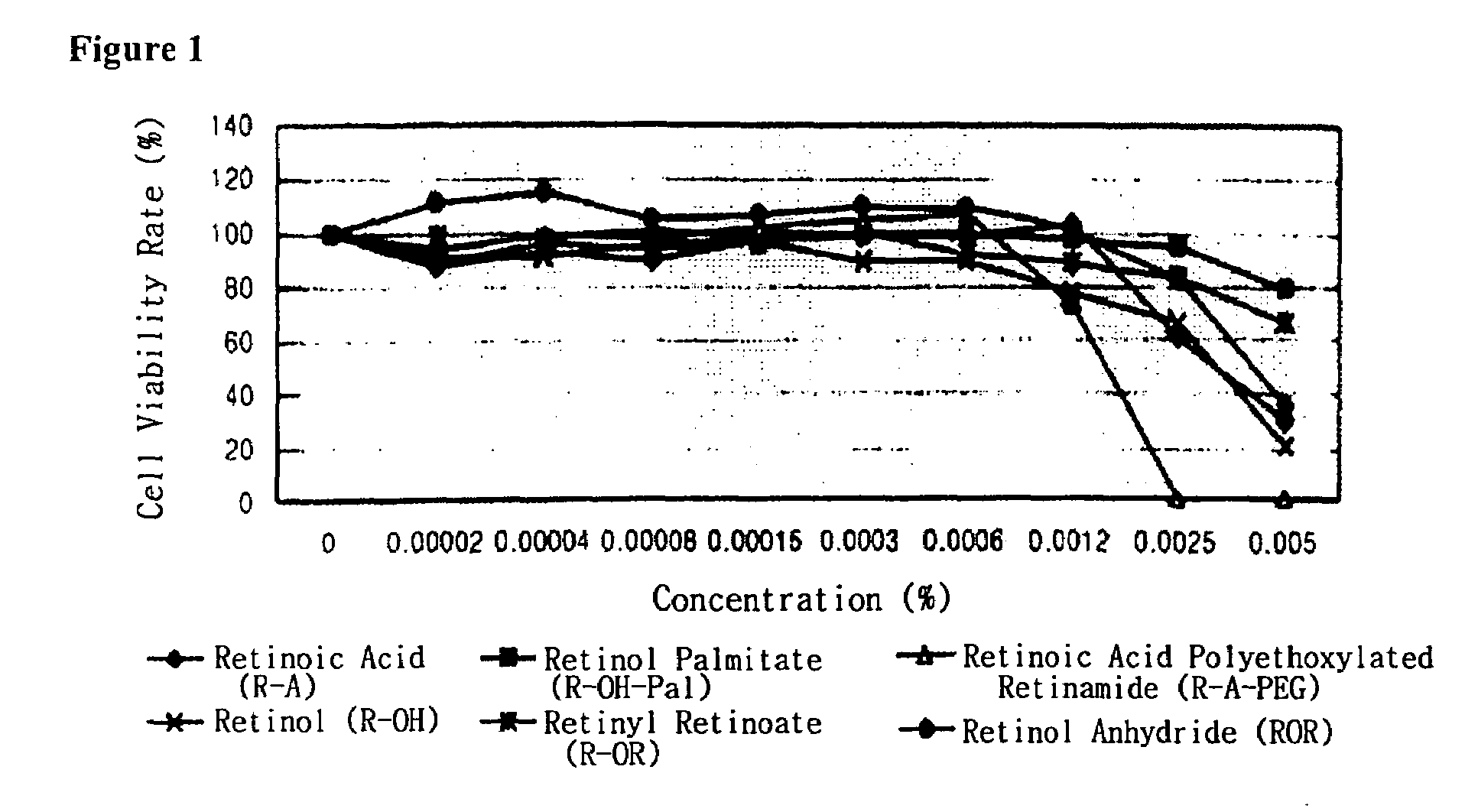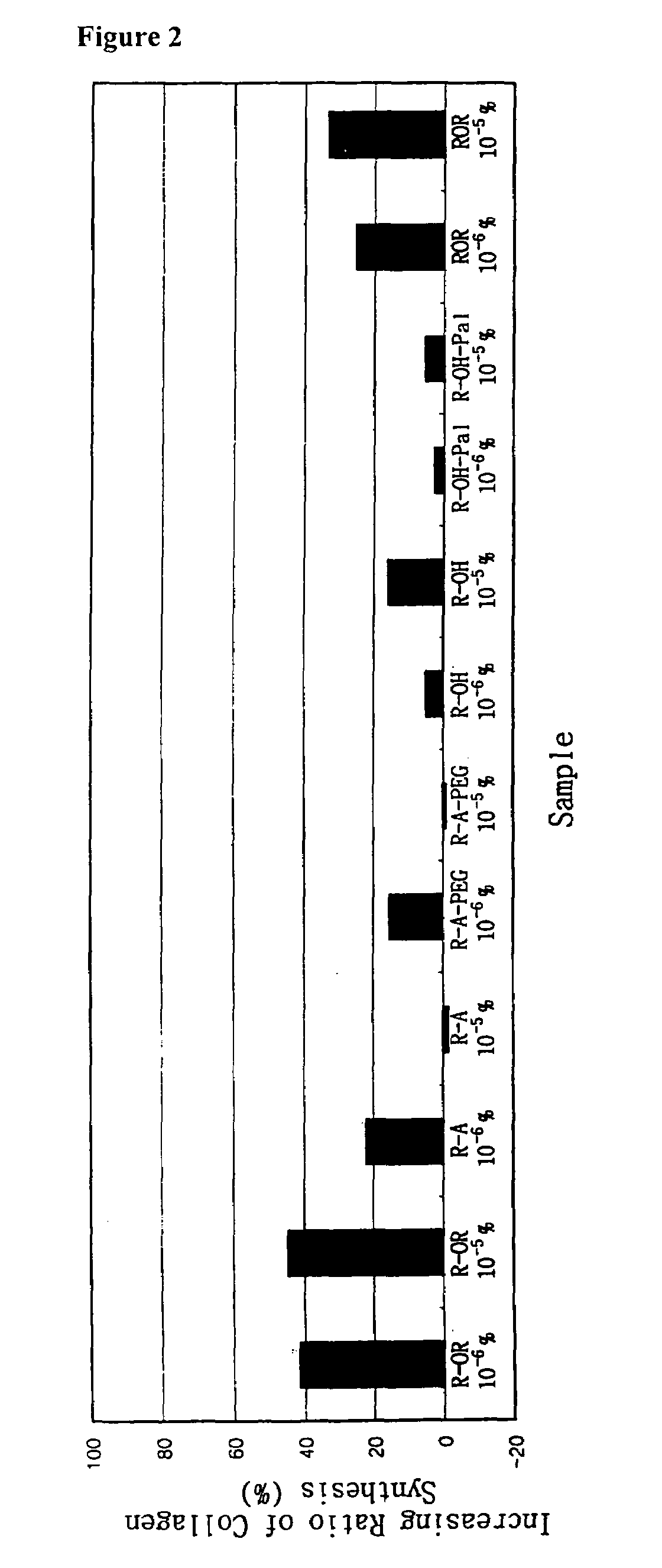Method for the improvement of skin wrinkles using retinyl retinoate
a technology of retinoate and retinol, which is applied in the field of new retinal retaliate, can solve the problems of retinol, retinol, and its derivatives are still so unstable, and can not be used, and achieve the effect of deterring skin aging and deterring skin aging
- Summary
- Abstract
- Description
- Claims
- Application Information
AI Technical Summary
Benefits of technology
Problems solved by technology
Method used
Image
Examples
example 1
Preparation of the Retinal Retaliate of Formula (1)
[0039]Retinoic acid (1.26 g, 0.0042 mol, Basf Co.), dicyclohexylcarbodiimide (DCC) (0.87 g, 0.0042 mol) and catalytic amount of dimethylaminopyridine (DMAP) were added to retinol (1.00 g, 0.0035 mol) dissolved in anhydrous dichloromethane (50 ml) at 0° C. The reaction solution was slowly warmed to room temperature and stirred for 12 hours under nitrogen atmosphere and under the condition for light and moisture to be intercepted. The reaction solution was filtered and the solvent was removed by distillation under reduced pressure. The residue was purified by column chromatography (silica gel 60 for cc part, Merk Co., mesh size 270–400, hexane / diethylether=19 / 1, v / v) to give 1.55 g (Yield 78%) of the pale yellow title compound.
[0040]1H NMR (300 MHz, CDCl3) δ 7.03 (dd, 1H, J=26.4 Hz, 11.4 Hz, C20H), 6.67 (dd, 1H, J=26.4 Hz, 11.4 Hz, C11H), 6.34 (d, 2H, J=2.1 Hz, C19H, C12H), 6.29 (d, 2H, J=2.1 Hz, C7H, C24H), 6.18 (d, 2H, J=9.9 Hz, C23...
example 2
Preparation of the Retinal Retaliate of Formula (1)
[0044]Retinol anhydride (1.00 g, 0.0017 mol) and triethylamine (0.31 g, 0.0021 mol) were added to retinol (0.60 g, 0.0021 mol) dissolved in anhydrous dichloromethane (30 ml) at 0° C. The reaction solution was slowly warmed to room temperature and stirred for 5 hours under nitrogen atmosphere and under the condition for light and moisture to be intercepted. The reaction solution was filtered and the solvent was removed by distillation under reduced pressure. The residue was purified by column chromatography (silica gel 60 for cc part, Merk Co., mesh size 270–400, hexane / diethylether=9 / 1, v / v) to give 0.91 g (Yield 92%) of the pale yellow title compound. 1H NMR data of this compound were the same as those in Example 1.
example 3
Preparation of the Retinal Retaliate of Formula (1)
[0045]Retinoic acid (1.00 g, 0.0033 mol) was dissolved in anhydrous toluene (10 ml) and phosphorus trichloride (PCl3) (0.46 g, 0.0033 mol) was added dropwise thereto. The mixture was stirred for 15 hours at room temperature under nitrogen atmosphere and under the condition for light and moisture to be intercepted. The retinoic acid chloride solution thus obtained was added dropwise together with the retinol prepared in Preparation 1 (0.95 g, 0.0033 mol) and triethylamine (0.61 g, 0.0041 mol) to anhydrous methylene chloride (30 ml) over 20 minutes at 0° C. The reaction solution was then stirred for 5 hours at room temperature. The reaction solution was added to saturated aqueous sodium chloride solution (30 ml). The organic layer was separated, washed with water, dried over sodium sulfate, filtered, and concentrated. The residue was purified by column chromatography (silica gel 60 for cc part, Merk Co., mesh size 270–400, hexane / diet...
PUM
| Property | Measurement | Unit |
|---|---|---|
| temperature | aaaaa | aaaaa |
| temperature | aaaaa | aaaaa |
| temperature | aaaaa | aaaaa |
Abstract
Description
Claims
Application Information
 Login to View More
Login to View More - R&D
- Intellectual Property
- Life Sciences
- Materials
- Tech Scout
- Unparalleled Data Quality
- Higher Quality Content
- 60% Fewer Hallucinations
Browse by: Latest US Patents, China's latest patents, Technical Efficacy Thesaurus, Application Domain, Technology Topic, Popular Technical Reports.
© 2025 PatSnap. All rights reserved.Legal|Privacy policy|Modern Slavery Act Transparency Statement|Sitemap|About US| Contact US: help@patsnap.com



